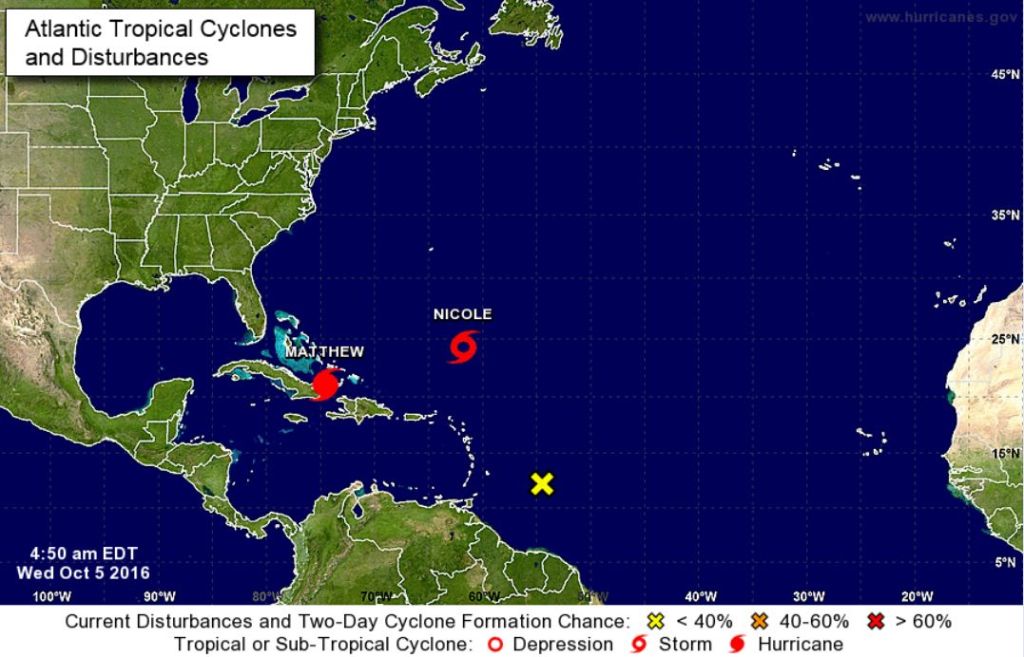More than 1 million people in coastal South Carolina were under evacuation orders Wednesday and state-of-emergency preparations were in force in Florida and Georgia as powerful Hurricane Matthew churned its way toward U.S. shores.
Matthew, one of the strongest storms in a decade, rolled through the Bahamas with winds up to 125 mph after lashing Haiti and Cuba, leaving a trail of destruction and at least 11 deaths. Winds and storm surges were expected to start hitting Florida on Thursday, and forecasters predicted the storm would hug the coast as it spun northward.
National Guard troops and other emergency teams were mobilized from Florida to South Carolina, where Republican Gov. Nikki Haley ordered widespread evacuations from low-lying areas. At one gas station in Mount Pleasant, S.C., the line of cars stretched a quarter mile.
“We don’t do voluntary or mandatory anymore. An evacuation is an evacuation,” Haley told reporters on Tuesday, urging people to move at least 100 miles inland.
Matthew hit the southwestern coast of Haiti early Tuesday, unleashing 145 mph winds and torrential rains that threatened to wreak new devastation across a country still reeling from a ruinous earthquake six years ago.
The eye of the Category 4 storm made landfall in Haiti around 7 a.m. Eastern time Tuesday but by the next day, it had been downgraded to a Category 3 with 125 mph winds, according to the Miami-based National Hurricane Center.
With the latest models showing the hurricane tracking westward toward Florida’s Atlantic coast, Republican Gov. Rick Scott sternly warned residents in Matthew’s path to be ready to evacuate. Scott has declared a state of emergency, activated 200 National Guardsmen and put 6,000 more on standby.
The NHC said the storm is expected to pass close to Florida by Thursday evening after passing through the Bahamas.
“Once this storm comes, we cannot put our first responders in harm’s way,” he said. “You must leave before it’s too late. You can rebuild a home; you can rebuild a business; you cannot rebuild a life.”
“We have to be prepared to be hit by a catastrophic hurricane,” he said, adding that a direct hit could bring “massive destruction we haven’t seen in years.”
The storm passed close to the U.S. Naval base in Cuba’s Guantanamo Bay and hit the nearby resort town of Baracoa, but otherwise did little damage to the remote and sparsely populated eastern tip of the island.
The Navy had evacuated about 700 spouses and children of service members as a precautionary measure.
Because of lingering uncertainty about the track Matthew would ultimately take, forecasters warned that practically the entire east coast of Florida should brace for hurricane or tropical storm impacts Thursday and Friday, including heavy rain of four to seven inches – and up to 10 inches in spots – in the Upper Florida Keys northward to the east-central coast. The system then is expected to barrel up the East Coast toward the Mid-Atlantic into the weekend, The Washington Post’s Capital Weather Gang reported.
The storm is the strongest Caribbean hurricane in nearly a decade and the most powerful to hit Haiti in 52 years, since Hurricane Cleo struck in the same location.
In Haiti – where tens of thousands of people still live in tents after losing their homes in the 2010 earthquake that killed more than 200,000, and where thousands more died in a subsequent cholera epidemic blamed on U.N. peacekeepers – Hurricane Matthew battered coastal shantytowns as it came ashore.
At least 11 deaths were attributed to the storm as of early afternoon Tuesday. However, the full extent of the damage and casualties won’t be known until the storm passes and relief services arrive.
Among the reported dead were five in Haiti and four people in the neighboring Dominican Republic, including three children who were killed when the walls of their home collapsed, news agencies reported. Last week, two people died in the storm – in Colombia and on the Caribbean island of St. Vincent.
UNICEF warned that more than 4 million children were at risk in Haiti.
“This is the worst storm Haiti has seen in decades, and the damage will no doubt be significant,” Marc Vincent, UNICEF’s representative in Haiti, said in a statement. “Waterborne diseases are the first threat to children in similar situations – our first priority is to make sure children have enough safe water.”
With the storm expected to linger over land masses, the National Hurricane Center forecast 15 to 25 inches of rainfall on southern Haiti and the southwestern Dominican Republic, with as much as 40 inches falling in some places. Eastern Cuba and northwestern Haiti were projected to get eight to 12 inches, and up to 20 inches in isolated spots.
As a result, the center said, “life-threatening flash floods and mudslides are likely from this rainfall in southern and northwestern Haiti, the southwestern Dominican Republic and eastern Cuba.” In addition, it said, storm surges of up to 10 feet could hit the southern coasts of Haiti and Cuba.
Copy the Story LinkSend questions/comments to the editors.



Success. Please wait for the page to reload. If the page does not reload within 5 seconds, please refresh the page.
Enter your email and password to access comments.
Hi, to comment on stories you must . This profile is in addition to your subscription and website login.
Already have a commenting profile? .
Invalid username/password.
Please check your email to confirm and complete your registration.
Only subscribers are eligible to post comments. Please subscribe or login first for digital access. Here’s why.
Use the form below to reset your password. When you've submitted your account email, we will send an email with a reset code.